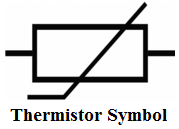Basically, both thermistors and thermocouples are temperature measuring transducers. But the principle used by them for sensing temperature variations is different. Thermocouple transducers are active transducers i.e., they do not require any external source of excitation for their operation. Whereas the thermistors are passive transducers i.e., they require an external source of excitation to measure the input non-electrical quantity applied.
The thermistor is a thermal resistor which means the resistance of the thermistor depends upon temperature. Thermocouples are comprised of two metal alloys that induce a voltage when there is a change in temperature.
Definition of Thermistor :
The name thermistor means thermal resistance i.e., it is the combination of words thermal and resistor. It means the resistance of the thermistor depends upon temperature, the resistance varies if there is a variation in the temperature. They are made up of semiconductor material.
Depending upon the temperature coefficient there are two types of thermistors. They are positive temperature coefficient thermistors and negative temperature coefficient thermistors.
The negative temperature coefficient or NTC thermistors have inverse relation between their resistance and temperature variations. If the temperature increases the resistance decreases and vice versa. In positive temperature coefficient or PTC thermistors, there exists a direct relation, the increase in temperature increases its resistance.
By measuring the change in resistance value, the temperature change can be determined. Thermistors are highly sensitive to temperature variation, which can sense small variations in temperature. Generally, negative temperature coefficient thermistors are widely used.
Definition of Thermocouple :
A thermocouple is a temperature transducer extensively used for the measurement of temperature variations. It is constructed by joining wires made from two metals made up of different materials forming two junctions. When one of the junctions is subjected to temperature variations it induces a voltage at another junction.
The amount of induced voltage depends upon the amount of temperature variation and the characteristics of the metals. By measuring the voltage the temperature change can be determined. Thus it converts thermal energy into electrical energy without any external source of power, hence it is an active transducer. Let us see the differences between thermistors and thermocouples.
Difference Between Thermocouples and Thermistors :
| Thermocouples | Thermistors |
|---|---|
| Thermocouples are temperature sensing devices made up of a combination of pure metals and alloys of copper, constantan, chromel, platinum, etc. | Thermistors are thermally sensitive resistors made up of ceramic or polymers materials such as manganese, nickel, cobalt, copper, uranium, etc. |
| The working of thermocouples is that it induces a voltage when there is a change in temperature and the voltage is proportional to temperature. | Thermistors have Negative Temperature Coefficient (NTC) i.e., it exhibits non-linear characteristics between resistance and temperature. |
| It can measure wide ranges of temperatures ranging from -200° to 1250°C. | It measures narrow ranges of temperature ranging from -50°C to 300°C. |
| The voltage generated by the two junctions at different temperature acts as a sensing parameter. | Resistance acts as a sensing parameter in the case of thermistors. |
| It possesses linear characteristics. | It possesses non-linear characteristics. |
| It is an active transducer. | It is a passive transducer. |
| The sensitivity of thermocouples is medium. | More sensitive to temperature variations compared to thermocouples |
| Slow output response. | Speed of response is high compared to thermocouples. |
| These are less accurate. | These are the most accurate temperature sensors. |
| Thermocouples are inexpensive. | Thermistors are more expensive than thermocouples. |
| These are robust in nature. | These devices are fragile. |
| Thermocouples read the relative temperature. | Thermistors read the absolute temperature. |
| Thermocouples are used in industrial furnaces. | Thermistors are used in home appliances. |
Therefore, both thermocouples and thermistors are temperature sensing transducers. Thermocouples are used for industrial applications and thermistors are used in home appliances like refrigerators, ovens, etc. Other than this thermistors can be also used to measure vacuum, pressure, and level of liquids.




